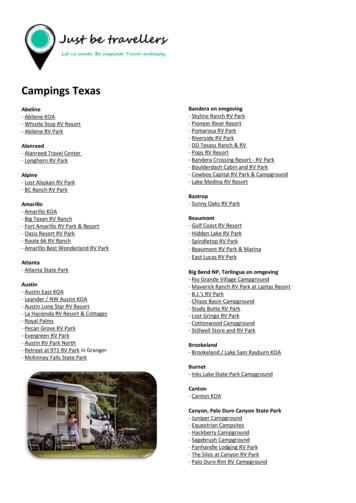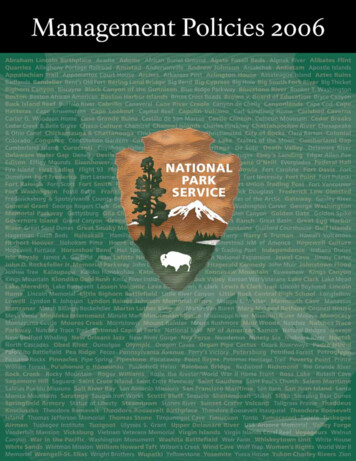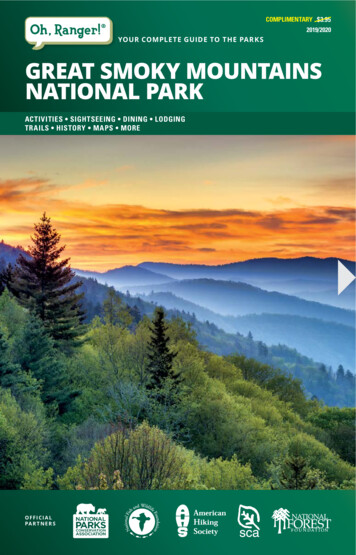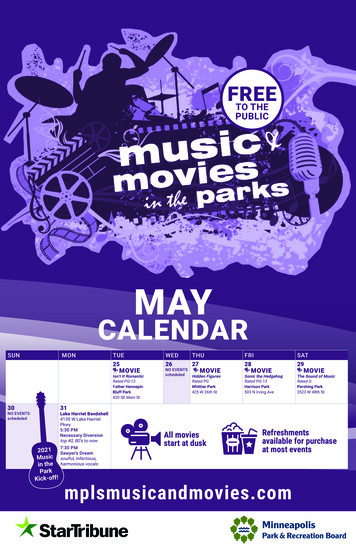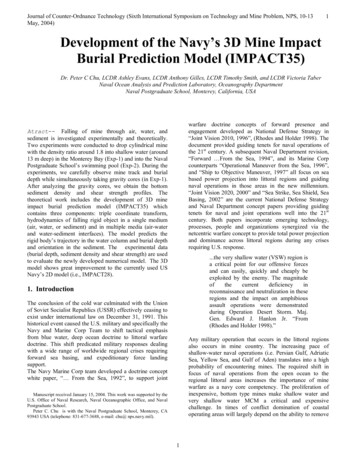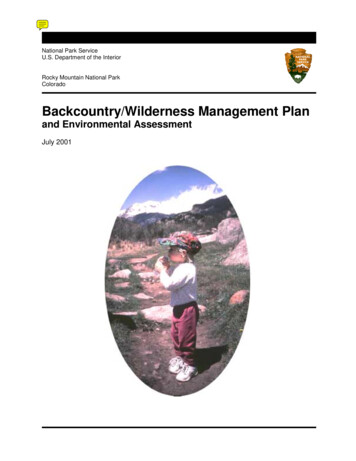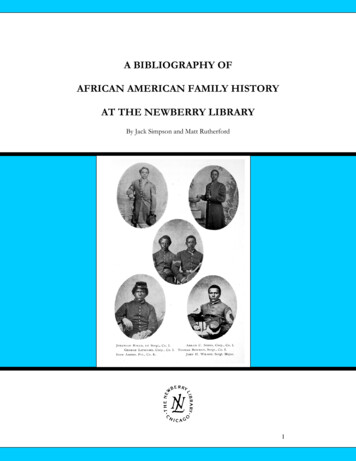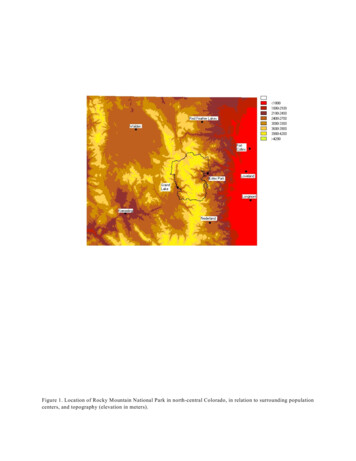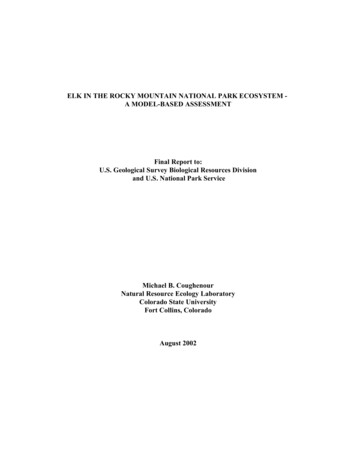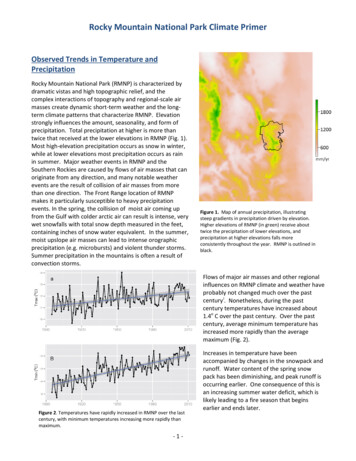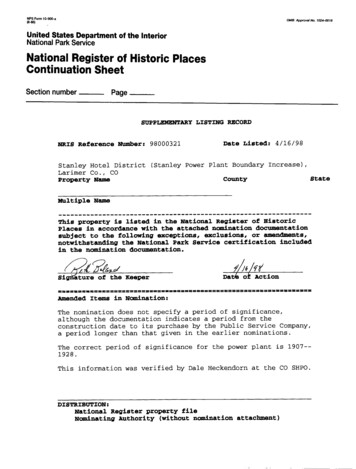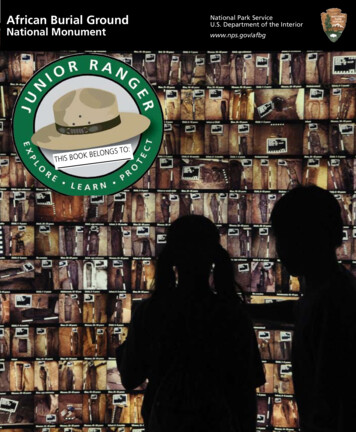
Transcription
African Burial GroundNational Monumentwww.nps.gov/afbg:ONGS TOK BELTHIS BOONational Park ServiceU.S. Department of the Interior
Welcome to African Burial GroundNational MonumentThis book is your guide to becoming a Junior Park Rangerat African Burial Ground National Monument.To earn your badge:1 Explore the 2 Hear RangersAdaptabilityAdaptability means adjusting oradapting to a new surrounding.memorial& the visitorcentertell the stories ofthe AfricanBurial Ground.3 Complete at leastfour (4) of theactivitiesLet the fun begin!African Burial Ground National Monument is one of the manyNational Parks in the United States.The National Park Service protectsand preserves places that are special tothe American people.Park Rangers care for National Parks.Describe what else a Park Rangerdoes:You can use this space to stampyour book with the officalAfrican Burial Groundpassport stamp.Ask aRanger abouttoday’s visitorprograms!did you know?African Burial Ground National Monument is one of nearly 400National Parks across the country and one of 22 special destinations inthe 10 parks that make up the National Parks of New York Harbor.2
ArtifactsWhat artifacts do you see that were buried with the Africans’ bodies? The names ofsome artifacts found in the burial ground are all mixed up! Unscramble them if youcan. Once they are unscrambled draw a line to the picture of each type of artifact.Bonus Challenge:The underlined letters spell something out. Can you figure it out?uffc kiln sdaeb tutbon ipns nrig ptneadn Learn from the Past3
LanguageAfricans spoke many different languages. One of the languages spoken in Senegal isWolof.I come from Mangi deka fiHello Diama ngmaThank you DieuredieufMy name is la tudahWrite the following sentences in Wolof.Hello. My name is write your name here.I come from write where you are from here.Did You Know?The African Burial Ground is the final restingplace of approximately 15,000 free andenslaved Africans.4
Who Am I?In the 17th and 18th centuries, African men, women and children lived harsh lives,but that didn’t stop them and their determination to become free. Walk around thevisitor center to learn more about some of the people who lived during this timeperiod.a.) I lived and worked on a farm in Brooklyn, N.Y. When the slaveholder died he saidthat my husband and I were not to be sold and that we could have off every Saturdayafternoon to work for ourselves. Who am I?b.) I was one of the first captive Africans brought to New Amsterdam. After years ofbeing enslaved, I was granted land through my appeal for freedom in 1644. Who amI?c.) Women in the household became alarmed of me when I started to “trifle aboutcharms.” That’s when I was put up for sale. In John Watt’s letter, he described me as“a very good cook” and “a most necessary servant.” Who am I?d.) I was identified as jumping out of a window and over fences during a series offires in New York. I eventually was caught and found guilty of conspiring with othersto kill people in the city. Who am I?e.) In 1733, I ran away from the slaveholder Jacobus Van Cortlandt. A runaway adwas soon published describing me as a tall fellow who spoke very good English.Who am I?f.) I worked off my purchase price as a grave digger and caretaker for the John StreetMethodist Church. Once free I co-founded the African Methodist Episcopal Churchin 1796. Who am I?Visit the National Park Service Web site at www.nps.gov. Find the pagetry this later!with the national map on it. See what other National Parks are in yourhome state. Do any of these parks teach the history of African Americans?Now that you are becoming a Junior Park Ranger, why not alsobecome a WebRanger? Visit www.nps.gov/webrangers to learn more.There is even an activity about the National Parks of New York Harbor.5
SymbolsMany cultures use symbols like the Akan symbols you see here. Draw your own symbol. Whatdoes it mean?Wisdom & PrudenceHopeGuardianshipPatience & toleranceWhat Is The Same & What Is Different?In one box, draw what you think a cemetery looks like. Draw what the African Burial Groundlooks like in the other box.6
Be A ReporterPretend you are a reporter who must get informationfor a newspaper article about the community’s interestin the site. Use the exhibit to fill in timeline dates tofill in the blanks for your story.African Burial Ground is rediscovered.419 sets of human remains are sent to Howard University.Researchers at Howard University finish recording andmeasuring remains.Government Services Administration (GSA) announcesthe selection of five (5) finalists for theAfrican Burial Ground memorial.All 419 remains return to the burial groundduring the Rites of Ancestral Return.The design is chosen for the outdoor memorial.President George W. Bush designates theAfrican Burial Ground as a national monument.The African Burial Ground National Monument memorialopens to the public.The African Burial Ground National Monument Visitor Centeropens to the public.7
Fill In The BlankA is poured to honor the ancestors— those who have passed on to the afterlife.Researchers atstudied 419 burials excavated from the AfricanBurial Ground.About 40% of those buried in the burial groundwere .Burial # was a child 6-11 years old (*Hintwhen looking at the images of the excavatedremains look in the 7th row from the bottom)New York proclaims the dateas Emancipation Day, generally ending slavery inthe state.FreedomWhat does freedom mean to you? Write or draw your answer in the space below.Did You Know?The African Burial Ground was designated aNational Monument on February 27, 2006 bya Presidential Proclaimation.8
MemorialAnswer the following questions about the African Burial Ground memorial.1.) Do you see any patterns or shapes being repeated at the memorial? (For example:spirals, circles, straight lines)2.) What adjectives would you use to describe the memorial? (big, serious, etc.)3.) What makes this memorial different from or similar to other memorials you mayhave seen?4.) Look at the area around the memorial and answer the following:a.What man-made objects do you see? (Buildings, roads, etc.)b.What naturally occurring features do you see? (Trees, water, etc.)5.) Do your observations from question #4 give you any clues as to what this area waslike in the past?6.) What do you think the future holds for this memorial?7.) How would the loss of this memorial affect the neighborhood and community?9
AfricaDid you know Africa is the second largest continent on the planet Earth?Color Africa your favorite color.Did You Know?The African Burial Ground is estimated to beabout 6.6-acres or 5 blocks. You can see thethe burial ground laid out over the modernday street map of New York City.10
Experience Your America.The National Park Service began to care for African Burial GroundNational Monument in 2006. This site is now a place to reflect onhow enslaved and free Africans and African-Americans helpedbuild New York City and their continuing legacy in the community.National Park Rangers care for all National Parks, but it is a job wecannot do alone. The stewardship of the American people is vital tothe well-being of our national treasures.Stewardship is the carefuland responsible managementof something entrusted to aperson or community’s care.What are some things YOU can do to help care for our NationalParks?Color in the arrowhead when youget home!try this later!The arrowhead is thesymbol of the NationalPark Service.The sequoia tree and thebison represent nature, themountains and waterrepresent recreation, and thearrowhead represents historyand archeology.The emblem symbolizes thevalues of National Park Rangers.Congratulations! You have completed the Junior Park Ranger guide forAfrican Burial Ground National Monument. Present your completed booklet to aPark Ranger and receive your badge.11
African Burial GroundNational MonumentJunior RangerCertificateI, ,promise to share what I have learnedtoday with others. I will explore,preserve and protect America’sNational Parks, so that through mystewardship, they will be preservedfor future generations.Junior RangerCertifying Park RangerDate
visitor center to learn more about some of the people who lived during this time period. a.) I lived and worked on a farm in Brooklyn, N.Y. . Visit the National Park Service Web site at www.nps.gov. Find the page with the national map on it. See what other National Parks are in your . The
